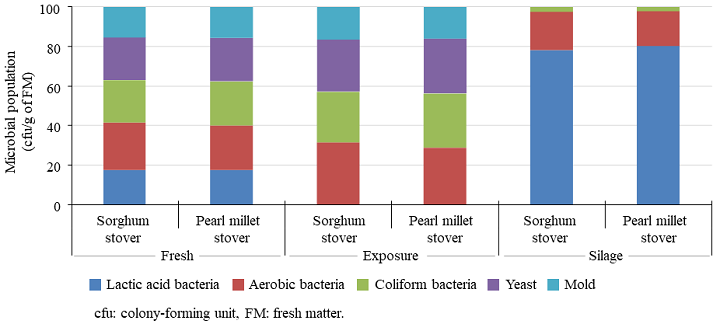Silage preparation improves feed utilization of sorghum and pearl millet stover
Description
Sorghum (Sorghum bicolor [L.] Moench) and pearl millet (Pennisetum glaucum L.) are the main crops in the semi-arid region of West Africa. After harvest, the stovers of the two crops are usually exposed and stored outdoors. These stovers are used as roughage for ruminants during dry season when there is a severe shortage of feed. However, the drying of feed resources is the only storage method in this area, and a longer storage time reduces the nutritional value of feed due to leaching and decomposition of nutrients. Therefore, silage prepared using crop stover is expected to alleviate feed shortages in the dry season and improve livestock productivity.After panicle harvest, the sorghum and pearl millet stovers were exposed in the field and garden for 120 days under natural weather conditions. At the same time, fresh stover silages were prepared using a small-scale fermentation system and stored for 120 days. Compared to fresh stover, both types of stover after 120 days of exposure reduced crude protein and fat content and energy, and increased indigestible crude fiber and lignin. On the other hand, stover silage preparation produced good-quality feed, and the nutrients were not lost after 120 days of ensiling (Fig. 1). Lactic acid bacteria were present in both fresh stovers, but after 120 days of exposure, the counts of harmful microorganisms such as aerobic bacteria, coliform bacteria, yeast, and mold increased, and no lactic acid bacteria were detected. After 120 days of ensiling, lactic acid bacteria became the predominant population and inhibited the growth of harmful microorganisms. As far as the microbial community is concerned, there were no great difference between crop stovers under the same storage treatment (Fig. 2). The prepared silage was of good quality, lactic acid fermentation reduced the pH, and low moisture inhibited butyric acid fermentation. The silage did not deteriorate, and the feed nutrients were well preserved for a long time. Sixteen native beef cattle with an average weight of 257.4 ± 13.5 kg were fed 1 kg of concentrate and free-feeding roughage, including sorghum stover and silage. The intake and feed utilization rate of stover silage significantly (p<0.05) improved compared to exposed stover (Fig. 3).
In terms of utilization of results, farmers in the semi-arid areas of West Africa can easily use local crop stover resources for silage, reducing the shortage of feed for ruminants in the dry season. The silage preparation technology will be released as a technical report by the CNRST (Burkina Faso National Center for Scientific Research and Technology) to improve local livestock raising method. Fresh sorghum and pearl millet stovers after harvest usually have low moisture, so when preparing silage, the moisture should be adjusted to about 60%.
Figure, table
-
Fig. 1. Storage of crop stovers during exposure and ensiling (left) and changes in their chemical composition (right)
a, b Means of three samples differ significantly (p<0.05).
-
Fig. 2. Microbial population due to differences in the preservation method of crop stover
-
Fig. 3. Dry matter intake and feed utilization rate of beef cattle due to differences in storage method of sorghum stover
Feed utilization rate = cattle intake / total feed × 100%.
a, b Means of eight cattle differ significantly (p<0.05).
- Affiliation
-
Japan International Research Center for Agricultural Sciences Crop, Livestock and Environment Division
- Classification
-
Research
- Research project
- Program name
- Term of research
-
FY2020(FY2016~FY2020)
- Responsible researcher
-
Cai Yimin ( Crop, Livestock and Environment Division )
Yamasaki Seishi ( Crop, Livestock and Environment Division )
Jethro Delma ( Environmental Institute for Agricultural Research, Burkina Faso )
Nignan Man ( Environmental Institute for Agricultural Research, Burkina Faso )
- ほか
- Publication, etc.
-
https://doi.org/10.1111/asj.13463
Cai Y et al. (2020) Animal Science Journal, 91(1):e13463
- Japanese PDF
-
2020_A05_A4_ja.pdf454.81 KB
2020_A05_A3_ja.pdf454.48 KB
- English PDF
-
2020_A05_A4_en.pdf475.34 KB
2020_A05_A3_en.pdf476.26 KB
- Poster PDF
-
2020_A05_poster.pdf265.1 KB
* Affiliation at the time of implementation of the study.



